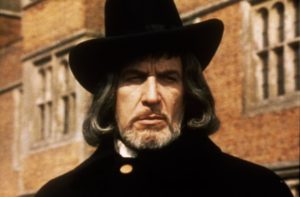Mandy (2018)
It’s no secret among my friends that I am a huge fan of Panos Cosmatos’ previous film, Beyond The Black Rainbow. That being said, I went into Mandy with a lot of hesitance. How could Panos top such a sleeper hit and was his initial success just a case of beginner’s luck? Not to mention the slew of hype surrounding the film had all the wrong signs of something being forced on us as a tailored piece of aesthetica. Beyond The Black Rainbow held a very special place in my heart as one of the few modern genre films capable of delivering the fabled “total package” of music, visuals and cerebral writing. There was a lot to live up to in every department. Could Panos pull off something that matched, let alone exceeded, his previous achievement? Mandy starts off as a dreamy period piece set in the Pacific Northwest. King Crimson’s ‘Starless’ sets the mood as gorgeous landscape shots paint the vastness of the setting. From the get go, the foreshadowing begins in the multitude of details presented. Everything immediately feels intentional, as is Cosmatos’ style. The house covered in windows sets the tone of slow building anxiety; the fragile shelter symbolizing the naivety of safety. This chapter is colored by the innocence of Mandy’s relationship to Nick Cage’s character. Their interactions aren’t the grand stuff of A and E dramas, they’re pictures taken amidst the quiet moments of real love. They live the life so many of us dream of; fucking off to live far away to watch B-movies with the one we cherish. The first act sets us up to develop a real emotional attachment to their relationship, something that I find is increasingly rare in today’s slew of characterless modern horror. The music in this chapter is soft and whimsical, bringing the viewer deeper into the lull of this illusion of security. There are hints of the darkness to come amidst the quiet meandering of clean guitars and hushed synth tones. The second act is when the shadows really start to run. The more lysergic elements of Cosmatos’ style begin to rear their head, slowly churning beneath the surface as the villains are slowly revealed. The more fantastic elements of the film seep in slowly, letting the realms of fantasy and reality blend comfortably together without it feeling too forced. Enter the cult. The horrific elements of Jeremiah, the leader, come from a place that is all too human The intensity of his dialogue when speaking to his underlings paints a vivid picture of a man in control and a mind addled with the poison of power. His yearning for Mandy is so familiar to any of us who have been pined after for simply being “exotic”. To him, she is built up in his own mind beyond her persona. She is romanticized as something rare that needs to be possessed. Through this mechanism, Cosmatos returns to his commentary on masculinity that he began in Beyond the Black Rainbow. Quietly plucked guitars turn to wailing highs and the shriek of feedback as the quiet of Mandy and her lover’s existence is shattered. Cosmatos’ execution of acid visuals blends effortlessly into the horror of Mandy’s abduction. The allusions to the Manson family are pretty immediate once Jeremiah starts sharing his own music with his captive in an effort to create another fanatic. From this point forward, Mandy proves that she is no object to be sought after nor will she be convinced. Jeremiah, like most men, launches into childlike fits upon being denied what he believes so rightly to be his. So as not to reveal too much about the ending of the film, I won’t speak too much on the third act. The music intensifies along with the action in perfect unison, the visuals get even more insane and you delve further into the mind of a man who has been pushed to the absolute limits of his humanity. The ride is intense, enjoyable and engrossing. The only symbol here that I will really touch on is the tiger. Early in the movie, Cage is seen wearing a shirt with a tiger on it. The tiger is a symbol of his passive masculinity. Later in the movie, the tiger is let out of the cage both literally and figuratively by the “chemist”. This is symbolic for LSD’s ability to awaken our innermost self. Cage’s character embraces the primal depths of his masculinity in order to seek revenge but at what cost? As the movie pans out to show the protagonist driving across a massive, otherworldly, landscape we are left to wonder if he has embarked on a permatrip and whether or not he has become exactly like the monsters that he sought out to destroy. Does embracing the depths of our primal capabilities of violence turn us into beasts even when the reason is justifiable? Is Mandy a cross examination of the masculine fantasy of revenge and warranted violence? Is Jeremiah symbolic of religious patriarchy? Is this a world where magic flutes and cursed swords really do exist or is this all the delusion of a group of LSD drenched minds? Only Cosmatos really knows but I’m glad he left so many things for us to ponder while he puts together his next film. Mandy is a movie that I both enjoyed watching, talking about and experiencing. It’s a movie that feels like it’s made with a lot of love by the right people. The fact that Nightbeast makes an appearance and that Cage’s weapon is the ‘F’ from the Celtic Frost logo just drives home the point that Panos Cosmatos is indeed “one of us”. This is even a step up from his previous work, bringing a total package that delves even deeper into his arguments of toxic masculinity and the dangers/benefits of LSD. For any of you who have walked out on the edge of that knife, this is a movie that may hit pretty...


